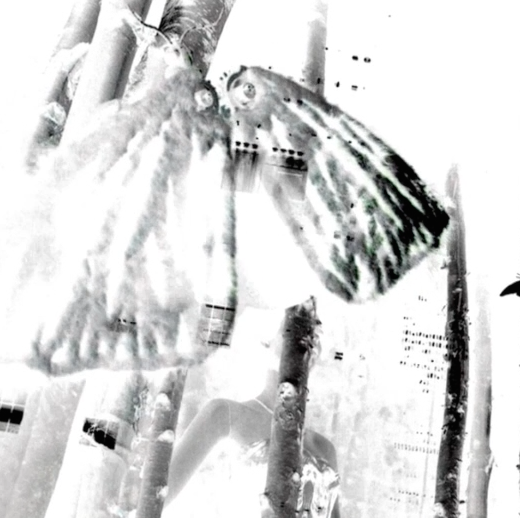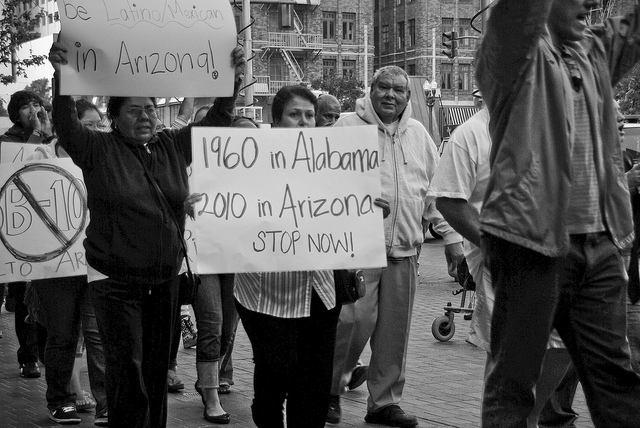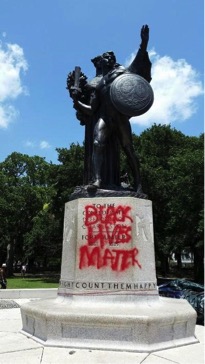Re-seeing Abu Ghraib: Cynical Rhetoric as Civic Engagement
Dubbed “The Torture Candidate” by Daily Kos, former Republican presidential hopeful Carly Fiorina came under criticism for her support of waterboarding and other Bush-era interrogation techniques—practices widely recognized by the international community as torture. Following last year’s condemnation of the CIA’s torture program by the Senate Intelligence Committee,1 Fiorina’s statements in support of so-called “enhanced interrogation” speak to a troubling amnesia concerning the United States’ treatment of detainees.
Ten years have passed since the release of amateur photographs depicting detainee abuse at Abu Ghraib Detention Center in Iraq. At the time, the release spawned a great deal of moral indignation, if not outright horror, forcing much of the US public to acknowledge the nation’s complicity in human rights violations. Given that the media and public had paid little attention to reports of prisoner abuse until the actual photographs were released, it is clear that visual spectacles remain an important vehicle for bringing troubling issues into the public sphere. But as the administration under George W. Bush became more invested in the promotion of these images as anomalies, their sharp rhetorical force began to splinter, deflect, even mute. Certain figures became fixed—like that of Lynndie England holding a leashed prisoner—while others simply faded from public view.2
With these more recent developments in mind, I propose harnessing Abu Ghraib’s fraught role by rethinking “cynicism” as a potentially productive critical stance toward visual texts, particularly images we find ethically troubling. A cynical rhetoric, I argue, might help us engage with and respond to a visual spectacularity that both attracts and deflects attention.
Contemporary perspectives on “cynicism,” much like those of the public toward “rhetoric,” often position cynicism pejoratively. Cynicism marks pessimism, inaction, unhelpful sarcasm, even hopelessness. In some instances, the Cynics3 of Ancient Greece have been rehabilitated as models of resistant rhetoric at the expense of modern-day cynics (see, for example, Sloterdijk and Žižek). But the key to productive redeployments of cynical rhetoric is not simply recovery of the ancient Cynics. Many of us choose not to operate, for example, within the level of publicness characterized by Cynics like Diogenes.4 But by recognizing cynicism as a means of rhetorical production, we might better understand it as also a strategic form of objection that helps us engage provocatively and in new ways with images in the public sphere.
Theorists have, it is fair to say, argued about the value and role of cynicism as an outlook on the social world. Peter Sloterdijk famously articulates cynicism with “enlightened false consciousness” and makes a firm distinction between cynicism, in that regard, and kynicism (Greek for “cheekiness”). The modern cynic, Sloterdijk explains, is “an integrated asocial character” with a “deep-seated lack of illusions” (192). Kynicism, conversely, he associates primarily with Diogenes, describing the well-known Greek figure as the “bird that flies solo, a provocative, stubborn moralist” (191). Slavoj Žižek, echoing Sloterdijk’s critique, offers a temporal frame for conceptualizing the two terms. Rather than seeing them as alternatives, he dubs cynicism a later stage of kynicism, framing cynicism as the ruling class’s response to the subversiveness of the kynic’s ridicule.
These distinctions between cynic and kynic, however, do not account fully for the rhetorical effects of cynical remarks or the role of audience(s). Indeed, the figure of the cynic, as outlined by Sloterdijk and Žižek, does not, it would seem, have to speak or say anything terribly cynical, at least by contemporary standards. Unlike the kynic of Ancient Greece who used sarcasm and irony to critique official norms and their implementation, the cynic has been theorized as a subject position created by the “ruling culture,” one characterized by silence, resignation, and inaction. But in practice, how do we know a cynic but by what he or she says or does? One area that deserves more attention in understanding the modern day cynical stance, then, is rhetorical production. I argue that the distinction between action and inaction, which others, like Žižek, have mapped onto kynicism and cynicism, respectively, can be complicated by the sarcasm, irony, and shock value of some cynical remarks.
The modern-day cynic might not operate from a position of exile or marginalization, but he or she nevertheless offers social, moral, or political critiques and advocates reform. Kristen Kennedy, for example, recasts ancient Cynic rhetoric as a strategic rhetoric of resistance with “insurgent potential” (37), arguing that Cynics “transgressed the limits of their assigned places in the polis as exiles” (32) in order to critique political hypocrisy. Others have noted the relationship between humor and social critique to better understand how cynicism works. George Yoos, using examples from 20th century cynics, argues, “the cynic’s sarcasm may be perceived as a form of moral shock therapy” (59). By recognizing cynicism as rhetorical we can see that even the most jaded cynic has the capacity to provoke response—even if that response takes the form of shock or moral outrage. Cynicism is interactive.
Unlike the cynic as characterized by Sloterdijk and Žižek, cynical rhetoric, through its use of irony, satire, disruption, and ambiguity, can have rhetorical force in contemporary contexts also because it typically arises in relation to things that matter. Cynics react to things of value, in situations where there is something at stake, which serves as a significant qualification to distinctions between kynics and cynics. Bill Maher, for example, likes labeling himself “pro-death.” While his comments can be undeniably shocking on that count, it is nevertheless clear that he values personal choice and individual responsibility. In comparison with pessimism, which is often conflated with cynicism, cynicism can thus be read as provoking action, rather than shutting it down (Yoos).
Cynicism, as a rhetorical position, necessitates production. As scholars and teachers of Rhetoric and Composition, we must often negotiate the lines between reception and production. And where our intervention into the public sphere ought to be is, arguably, in forms of production. By re-imagining cynicism’s utility as a productive stance, we can identify several tactics for intervention in matters of political and ethical import. Adopting cynicism requires us to introduce provocative language in the public sphere—especially when human rights are at stake.
The Atrocities at Abu Ghraib
Abu Ghraib exposed the public to the actions the US government and its troops were willing to sanction in the name of democracy. But where is Abu Ghraib now? Mark Danner, in his discussion of the complex role played by the photographs documenting detainee-abuse, calls Abu Ghraib a “peculiarly contemporary kind of scandal, with most of its plotlines exposed to view—but with few willing to follow them and fewer still to do much about them” (47). While the US military court-martialed lower-ranking soldiers for abusing detainees at Abu Ghraib, the United States, particularly the Bush administration, remained effectively insulated from the charge that the photographs are evidence of abuse derived from US policy and sanctioned by the US government. Despite considerable evidence produced by journalists like Seymour Hersh, the horror of the abuses depicted visually has to a certain extent distracted the public from the United States’ repeated violations of human rights and the systematic and sanctioned use of torture in interrogations. The Bush administration worked and re-worked official narratives to paint the perpetrators as sadistic individuals who acted alone.
It has been in the American public’s best interest to imagine that we are not complicit in the spectacle, that we are neither suffering from abuse, nor giving the thumbs up, nor holding the leash or operating the camera. As Diana George and Diane Shoos have argued, modes of visual communication can simultaneously “work to construct collective history” and “deflect political realities” (588).5 Our call, then, as scholars in English Studies, is to figure out where and how to intervene, given the ways in which our participation is (with and without our complicity) determined and circumscribed. If we have, by and large, been silenced on the issue of abuse, and if the photographs have indeed distracted us and dismayed us to the point of resignation, as Danner suggests, one way to counter this is through a cynical rhetoric that might allow us to both recognize and see beyond the spectacularity of some visual texts. As Fiorina’s, and later Donald Trump’s, troubling embrace of the Bush-era torture policies indicate, the time for critique and intervention is far from over. In what follows, I propose several features, or ways of characterizing, a cynical rhetoric that might productively guide our interventions in the public sphere.
Feature 1: Cynicism as Provocation through Kairotic Interruption
Provocation is in many ways the work of the Cynic tradition in Ancient Greece. Cynic tactics are, as Kennedy elegantly terms them, “impolite and disruptive” (26). Using what Kennedy calls an “impudent kairos” (36), Diogenes, for example, “positioned on the outskirts of culture,” acted as a parrhêsiast—one who speaks openly and at great risk—and in so doing created space to speak out (27).6 Cynicism is a form of provocation that operates largely outside dominant, accepted forms of critique; a cynical stance produces language that strategically transgresses accepted norms for communication, employing tactics like interruption, irony and wit, even incivility. Cynical rhetoric interrupts at the right moment, provoking response.
One key feature of this provocation is its timing. As Bill Maher’s deployment of cynicism in stand-up comedy reveals, cynical intervention is often timed to disrupt and violate expectations. Kairotic interruptions are not solely the provenance of Cynics, of course, but there are possibilities in the ancient Cynics’ legacy for intervening in contemporary discursive contexts, from protests to social media movements. Diogenes occupied and spoke out in places he was not supposed to be. When considered in terms of finding spaces from which to intervene and speak openly to those in positions of power, linking kairos with cynicism offers opportunities for creating rhetorical situations, for invention, especially when many would prefer that the conversation already be over. By creating positions and moments from which to speak we can call attention to the ways in which public speech is circumscribed, even silenced.7 We are responsible for not only viewing images of atrocity but also speaking out against injustices (Linfield). So a cynical rhetoric means that we might take up contentious topics and bring them out into the open, creating opportunities for openness and discourse, whether at our universities or in our research. It means refusing to let the Abu Ghraib photographs become fixed or fade from memory, from public discourse, no matter how uncomfortable that refusal may be.
Feature 2: Cynicism as a Critique of Norms and Value Systems
In its critique of social norms and the value systems that undergird those norms, cynical rhetoric actively problematizes social inequalities and abuses of power. In her work on cynical tactics of resistance, Kennedy argues that ancient Cynics employed parrhêsia “in an overtly political sense to speak openly to leaders and others with power to note their hypocrisies and abuses in government” (33). So we must determine what is of value and what is at stake in visual texts, then seek out not a scapegoat, but those who are responsible for setting in motion these abuses of power. By publicly rejecting claims that Abu Ghraib represents rogue soldiers or “‘Animal House’ on the night shift” (“Report”), as James Schlesinger tellingly asserted, and critiquing the values and policies that sustain the problematic treatment of detainees, we adopt a position that both acknowledges the way the system works and potentially disrupts it.
While torture is not generally understood to be an “accepted norm,” the abuses depicted in the Abu Ghraib photographs and those described in the testimonies of detainees and military police did indeed come to seem “normal” to the perpetrators. And other techniques, such as waterboarding, are apparently still up for discussion among presidential hopefuls, a trend that newly normalizes support for such interrogation practices. In the case of Abu Ghraib, the administration defined normality by making the convicted soldiers seem like outliers. A cynical rhetoric forces the question of how these norms are enacted and reproduced by re-instigating the conversation. It also questions the parameters of normality so as to rhetorically reposition the public gaze.
Feature 3: Cynicism as Civic Participation
I do not mean to say that cynicism is the only or best answer to the crimes at Abu Ghraib or newly prescient conversations about the legality of “enhanced interrogation”—certainly it is one response of many. In the context of human rights abuses, a cynical rhetoric may be read as callous, ignoring or at least minimizing the human costs of suffering, the physical and psychological damage inflicted on a person’s body by abuse. Rather than the self-imposed exile and Cynic naturalism embraced by Diogenes, the body plays a considerably different role in situations of human rights abuse, especially in the case of torture.
Because it evidences a rhetoric of confrontation, cynicism may also be understood as operating outside dominant, more authorized forms of critique. It may adopt “incivility,” in Kennedy’s words, and incivility in public contexts is typically unwelcome. The Cynic of Ancient Greece was both public and apart; critiquing dominant societal norms has been, historically, a very lonely position. Yet, in the case of interrogational torture, we cannot remain on the outside, holding ourselves entirely unaccountable. As someone officially exiled from the polis, who chose to inhabit a dog-like way of life, rather than more decorous living, Diogenes avoided, to some extent, implicating himself in the greed and excess he critiqued in society. But for Abu Ghraib, we should find it impossible to rise above the pain and humiliation inflicted in our names. We cannot maintain our separateness. We must instead locate ourselves both inside and outside by offering bold critique that calls attention to inequality and mistreatment, and by refusing to be silenced through calls for civility and politeness. We cannot exist fully in exile, separate from the social conditions we critique; we cannot decline to participate, nor can we simply apologize and move on—particularly when politicians seeking positions of power seem doomed to repeat history.
Rather than positioning us above the fray, a cynical approach calls attention to our implication in the value system that creates and sustains torture. This diverges somewhat from how we understand Diogenes’ case. Many of us, at least, remain complicit. And when confronted with evidence of detainee abuse at Abu Ghraib, evidence that confirms many of our fears of what pain and havoc might be wrought by the US government and US policy (in a war that made many of us exceedingly uncomfortable from the outset), we may be inclined toward frustration. But this is where we must find room to maneuver outside or in spite of the conditions that created Abu Ghraib, even if it means creating dissensus, rather than consensus.
Abu Ghraib is more than just the images captured by US service members. But we can neither reify nor ignore the rhetorical force of those photographs. And if they indeed limit possibilities for thinking about Abu Ghraib, and if they deflect attention from the normalized systems of thought and behavior that gave rise to them, then we are nothing if not bound to find ways to work differently. I suspect we already recognize the role of both the images themselves and the talk around those images as representations that allow us only limited access to the abuse suffered. As a stance from which to critically encounter visual texts, cynicism can strategically confront the deflection of responsibility that has so far determined the Abu Ghraib images’ reception and potentially disrupt these photographs’ static positions of spectacularity.
Carly Fiorina did not intend her remarks on the subject of interrogational torture to reopen debate but rather to establish her own credentials within an already-established narrative—she aims to short-circuit discussion, not to invite dialogue. A cynical approach, instead, seeks to reopen old wounds, to take up conversations about “enhanced interrogation” that petered out much too soon. It forces a re-seeing of the images we find so troubling, asking us to not only rehash old debates but also consider why the debate ended so quickly in the first place. A cynical approach refuses to let us off the hook. Why does Carly Fiorina think she can refer to waterboarding to burnish her foreign policy credentials? Because we stopped talking about it. We allowed the torture our nation commits to no longer be a timely topic of debate. Because it became easier not to look. A cynical approach instead demands that we look and look again and again at the man in the black hood, standing on the box, with electrodes hooked to his chest.
Endnotes
- See “Senate Committee’s Report on the C.I.A.’s Use of Torture” (The New York Times, 9 Dec. 2014). return
- The Obama administration has been similarly plagued by a lack of accountability. In 2011, the Department of Justice opened investigations into the deaths of two Iraqi detainees held in CIA custody (out of hundreds of such cases). In 2012, those two cases were closed. And yet, in 2014, a US federal appeals court reinstated a lawsuit by four Iraqi detainees who alleged that employees of CACI International, a defense contractor that provided interrogators to the US military during the Iraq War, directed their torture at Abu Ghraib and encouraged the soldiers guarding them to “soften them up” for interrogation. return
- I use “Cynic” (capitalized) to refer to both the people and the tradition associated with Ancient Greece. return
- While Diogenes is best known for inhabiting the agora, using only a tub for shelter, he was also an exile from Greece’s political polis and thus lived as a kind of “political pariah” (Kennedy 28). return
- Wendy Hesford, too, suggests that while there are redemptive possibilities in visual spectacles, the “spectacle of suffering” around which “human rights crises and activism often coalesce […] is open to cooptation and containment” (19). return
- Robert Bracht Branham’s “Defacing the Currency: Diogenes’ Rhetoric and the Invention of Cynicism” offers a thorough exposition of the verbal techniques and physical gestures that constituted Cynicism in Diogenes’ tradition. For more on Cynicism in Ancient Greece and the role of “unruly bodies,” see Louisa Shea’s compelling The Cynic Enlightenment: Diogenes in the Salon. return
- As Leif Vaage frames it, “in the mouth of the Cynic, parresia [sic] meant saying whatever whenever in such a way as to provoke the consistent sensation of ‘boldness’” (27). We might thus understand cynicism as a form of “going public” (27). return
Works Cited
- Branham, R. Bracht. “Defacing the Currency: Diogenes’ Rhetoric and the Invention of Cynicism.” The Cynics: The Cynic Movement in Antiquity and Its Legacy. Ed. R. B. Branham and M.-O. Goulet-Cazé. Berkeley: U of California P, 1996. Print.
- Danner, Mark. Torture and Truth: America, Abu Ghraib, and the War on Terror. New York: New York Review of Books, 2004. Print.
- George, Diana and Diane Shoos. “Deflecting the Political in the Visual: Images of Execution and the Death Penalty Debate.” College English 67.6 (2005): 587-609. Web. 27 Feb. 2011.
- Hersh, Seymour M. Chain of Command: The Road from 9/11 to Abu Ghraib. New York: Harper Collins, 2004. Print.
- Hesford, Wendy S. Spectacular Rhetorics: Human Rights Visions, Recognitions, Feminisms. Durham: Duke UP, 2011. Print.
- Kennedy, Kristen. “Cynic Rhetoric: The Ethics and Tactics of Resistance.” Rhetoric Review 18.1 (1999): 26-45. Web. 30 Mar. 2013.
- Linfield, Susie. The Cruel Radiance: Photography and Political Violence. Chicago: U of Chicago P, 2010. Print.
- “Report: Abu Ghraib was ‘Animal House’ at Night.” CNN. 25 Aug. 2004. Web. 13 Oct. 2013.
- “Senate Committee’s Report on the C.I.A.’s Use of Torture.” The New York Times. 9 Dec. 2014. Web. 15 Aug. 2015.
- Shea, Louisa. The Cynic Enlightenment: Diogenes in the Salon. Baltimore: Johns Hopkins UP, 2010. Print.
- Sloterdijk, Peter. “Cynicism – The Twilight of False Consciousness.” New German Critique 33 (1984): 190-206. Web. 25 Jan. 2014.
- Vaage, Leif E. “Like Dogs Barking: Cynic Parresia and Shameless Asceticism.” Semeia 57 (1992): 1-39. Web. 11 Apr. 2013.
- Yoos, George E. “The Rhetoric of Cynicism.” Rhetoric Review 4.1 (1985): 54-62. Web. 11 Feb. 2013.
- Žižek, Slavoj. “Cynicism as a Form of Ideology.” The Sublime Object of Ideology. New York: Verso, 1989. 28-30. Web. 25 Jan. 2014.
Cover Image Citation: https://www.flickr.com/photos/fibonacciblue/6170829009




 Laura Sparks is an Assistant Professor of English at California State University, Chico. She earned a Ph.D. in English (Rhetoric and Composition) at Indiana University, Bloomington (2014). Her current research focuses on the relationship between rhetoric and post-9/11 interrogational torture, with particular attention to digital human rights rhetoric and rhetorical constructions of urgency and timeliness. Recent publications and conference presentations include research on Kenneth Burke and Abu Ghraib, cynic rhetoric, and post-human approaches to digital delivery.
Laura Sparks is an Assistant Professor of English at California State University, Chico. She earned a Ph.D. in English (Rhetoric and Composition) at Indiana University, Bloomington (2014). Her current research focuses on the relationship between rhetoric and post-9/11 interrogational torture, with particular attention to digital human rights rhetoric and rhetorical constructions of urgency and timeliness. Recent publications and conference presentations include research on Kenneth Burke and Abu Ghraib, cynic rhetoric, and post-human approaches to digital delivery.